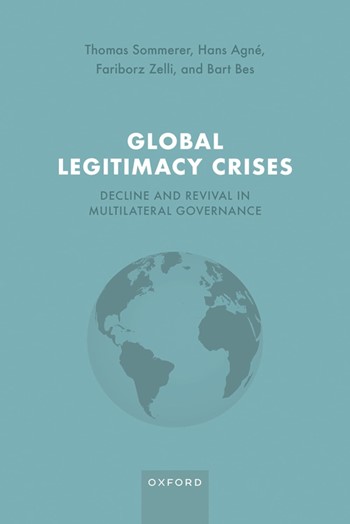Book Review - Global Legitimacy Crises: Decline and Revival in Multilateral Governance

Global Legitimacy Crises: Decline and Revival in Multilateral Governance, by Thomas Sommerer, Hans Agné, Fariborz Zelli, and Bart Bes. Oxford: Oxford University Press, 2022. 238 pp., £71 hardcover 9780192856326
We inhabit a world characterized by pervasive crises across political, economic, and social domains. Criticism from diverse perspectives particularly affects the fate of the liberal international order, and its norms and institutions.
Ian Clark (2005) once contended that legitimacy serves as a pivotal marker for tracing the ascent and descent of international orders, constituting historical landmarks. Today there is a renewed scholarly interest in comprehending the sources and effects of legitimacy crises in Global Governance Institutions (GGI). The concept of legitimacy, while longstanding in its examination, has undergone considerable evolution within the field of International Relations.
Thomas Sommerer, Hans Agné, Fariborz Zelli, and Bart Bes's 2022 book “Global Legitimacy Crises: Decline and Revival in Multilateral Governance” is not only very timely but also serves as an exemplary illustration of the scholarly advancements in the study of the sources and effects of legitimacy crises in GGIs. The book impressively adds to the recent scholarly debate with its specific emphasis on measuring the effects of legitimacy crises on International Organizations (IOs) capacity to rule: by employing a mixed methodology combining large-N studies with an in-depth case study of two crucial IOs and offering a persuasive and multidimensional analysis.
 Going beyond the classic scholarly and public perceptions which usually associate legitimacy crises with negative consequences, the book focuses on the “activating effects of legitimacy crises” on IOs (p.41). To better grasp those effects, in the first part of the book (chapters 2-3-4), the authors theorize and measure the legitimacy crises, and in the second part (chapters 5-6-7) they theorize and measure the impact of legitimacy crises on IOs. They capture this by focusing on the capacity to rule dimension which they argue to be a useful concept to better understand the potential effects of legitimacy crises on IOs (p. 5). One crucial strength of the book is the heavy emphasis on measuring the role of different audiences in legitimacy struggles as well as IO's capacity to rule. If we say the last thing first, one of the book’s main conclusions is that legitimacy crises are “double-edged swords that sometimes strike the capacity of much-needed multilateral organizations while sometimes strengthening it” (p. 3). More interestingly, the authors find only limited support for the expectation that legitimacy crises have significant consequences for IOs (p.129).
Going beyond the classic scholarly and public perceptions which usually associate legitimacy crises with negative consequences, the book focuses on the “activating effects of legitimacy crises” on IOs (p.41). To better grasp those effects, in the first part of the book (chapters 2-3-4), the authors theorize and measure the legitimacy crises, and in the second part (chapters 5-6-7) they theorize and measure the impact of legitimacy crises on IOs. They capture this by focusing on the capacity to rule dimension which they argue to be a useful concept to better understand the potential effects of legitimacy crises on IOs (p. 5). One crucial strength of the book is the heavy emphasis on measuring the role of different audiences in legitimacy struggles as well as IO's capacity to rule. If we say the last thing first, one of the book’s main conclusions is that legitimacy crises are “double-edged swords that sometimes strike the capacity of much-needed multilateral organizations while sometimes strengthening it” (p. 3). More interestingly, the authors find only limited support for the expectation that legitimacy crises have significant consequences for IOs (p.129).
The authors' noteworthy contribution lies not only in the revision of established theories about legitimacy and its crises by introducing novel predictions, but also empirically analyzing them through a mixed-methods approach. The book offers in-depth qualitative case studies of the United Nations Framework Convention on Climate Change (UNFCCC) and the WTO: based on expert interviews, analyses of key documents, and negotiations, in addition to quantitative analyses of 32 international organizations from 1985 to 2020, based on media coverage of elite criticisms and mass protests in leading global news outlets (p.48)
Although the authors argue that the media coverage enables them to analyze a maximally broad range of audiences, they also accept their limitation to English-speaking media sources, which could lead to an overrepresentation of the Anglo-Saxon domain or the Global North more generally. (p.51) In fact, the content and extent of information published in global media raises questions about the potential creation of epistemic injustice, due to inherent biases in the data and underscores the need for a more inclusive and diverse representation in media sources.
In Chapter 2, the authors introduce their novel theoretical and analytical framework about the legitimacy crises of IOs in terms of activated audiences, normative depth, and social breadth. The long time span of analyses in Chapter 3 and case studies in Chapter 4 help readers decipher a comparative picture of the crisis periods of various IOs and the actors involved, based on the theoretical framework. The authors demonstrate, for instance, that the “share of elite critiques outnumbers mass protests and street demonstrations”. (p.66) From Chapter 3, we learn that “some IOs had multiple or enduring crises—the EU tops this ranking with 15 crisis years, followed by NATO with 12 years” (p.71). The authors found that organizations that are active in security politics and human rights issues are mainly targeted by states and governments (p.70), while for organizations operating in the fields of economics, finance, development, and the environment, the challenges mainly come from nonstate actors. Interestingly, the WTO receives the highest share of contestation by governments, while also its share of nonstate contestations is quite high (67 percent) (p.70). One of the noticeable findings of Chapter 3, that is also in parallel with some recent research on GGIs, is that the most recent surge of legitimacy challenges only affected “a limited number of organizations, and often did not mark a historical high” (p.45).
The main research puzzle that guides chapters 5, 6 and 7 is how legitimacy crises might strengthen or weaken the capacity to rule of an organization, defined in terms of material capacities, institutional capacities, and decision-making capacities. In Chapter 6, surprisingly, the authors find only limited support for the expectation that legitimacy crises have significant consequences for IOs. We learn that “oftentimes, even peaks in public challenges do not result in measurable changes in IO resources, do not affect the mandate and formal authority, and have no consequences for the likelihood that IO member states adopt joint decisions.” (p.129) Combining results on the quantitative chapter with case studies, the authors contend in Chapter 7 that “IO legitimacy crises do not always result in measurable consequences” (p.156). The authors, on the other hand, demonstrate that a diverse range of critical audiences- meaning a higher degree of social breadth- increases the likelihood of resource cuts as well as decline in decision-making capacity for international organizations.
One of the most noteworthy findings of the book is that positive changes are equally likely for IOs in crises as negative changes. (p.129) In the long term, growing institutional capacity and higher decision rates can be the result of legitimacy crises. This tendency becomes particularly pronounced when the challenges associated with these crises encompass diverse types of audiences in IOs that have comprehensive policy mandates and provide increased levels of access to transnational actors (p.129). Therefore, the book also persuasively discusses the relationship between IO characteristics and the capacity to rule following legitimacy crises. IOs that cover multiple issues have a greater likelihood of experiencing downward shifts in decision-making when facing a legitimacy crisis, whereas task-specific organizations seem to be more resilient in this regard. (p.154) Again, in chapter 7, in which the authors delve into an in-depth discussion of the effects of the legitimacy crises of two IOs, the WTO and the UNFCCC, on their capacity to rule, we learn that there is much evidence of push for reform following periods of legitimacy crises (p.164).
This book therefore has important contributions and implications for reform discussions regarding IOs and has a lot to say about how to “fix global governance.” In sum, the authors adopt a comprehensive approach, examining various dimensions of legitimacy crises in a detailed, multifaceted, visualized, and reader-friendly manner. They smartly employ both qualitative and quantitative methods, extending the analysis beyond mere examination. The book is also very rich in terms of its references to previous and most recent studies on legitimacy in general and its effects on legitimacy crises, supported by a well-documented findings with many figures and tables.
Despite all the complexities and the inherent challenges in studying legitimacy, the book is also a concrete example of how legitimacy can be studied in the international context. However, as Ian Hurd (2019) nicely put it, it is essential not to overlook that rules in global governance always entail “winners and losers”. In this regard, there is still a tremendous need for studying the “real-life effects of legitimacy crises” of global governance institutions, and uncovering what has been “invisible” and “silenced”.
Overall, the most important and noticeable contribution of the book is that the authors persuasively demonstrate the activating effects of various actors’ perception of legitimacy crises on IOs as an observable and measurable phenomenon. I think it is one of the most theoretically and empirically rich studies on global governance in general and, legitimacy more specifically. Considering its specific purpose of measuring the “capacity to rule”, as well as “activating effects of legitimacy crises” from a multiple audience perspective, the book is pivotal in understanding the effects and the resolution of legitimacy crises, as well as reform discussions in GGIs. Therefore, it should be of interest to academics and students who study IOs and global governance, as well as practitioners, and bureaucrats of IOs searching for specific prescriptions and solutions to their problems.
Dr. Gonca Oguz Gok is Associate Professor of International Relations at Marmara University, Istanbul.
References
Clark, Ian Legitimacy in International Society, New York: Oxford University Press, 2005.
Hurd, Ian, “Legitimacy and contestation in global governance: Revisiting the folk theory of international institutions.” Review of International Organizations 14, 2019: 717–729.


